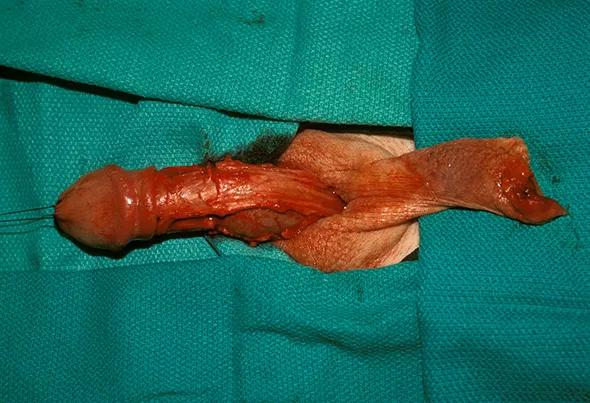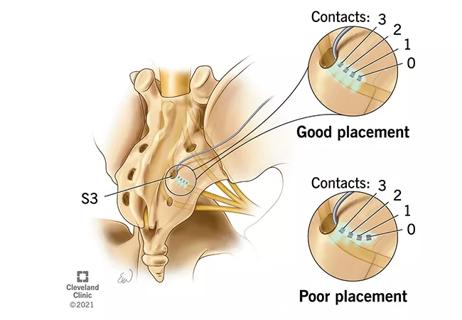Advertisement
If coitus is impaired, surgery can restore sexual ability

Advertisement
Cleveland Clinic is a non-profit academic medical center. Advertising on our site helps support our mission. We do not endorse non-Cleveland Clinic products or services. Policy
Peyronie disease (PD) occurs in as many as 9 percent of middle-aged and older men. It is caused by plaque formation in the tunica albuginea, thought to result from repeated minor injuries to the penis during intercourse. The goal of treatment is to restore or maintain the ability to have intercourse.
As a prelude to the following discussion of PD, penile fractures are uncommon, dramatic injuries that occur during coitus in young men with fully rigid erections. If a large force is applied to these erections during sexual activity, there is sharp pain followed by penile swelling and ecchymosis. Surgical exploration reveals a tear in the elastic covering (tunica albuginea) of the erection chambers at the base of the penis. When the tear is surgically repaired, future erections remain straight. If surgical repair is not done, a palpable scar (placque) develops at the base of the penis and erections curve toward the side of this inelastic placque.
PD has some things in common with penile fracture. Typically, men with PD still have erections suitable to initiate coitus; however, erectile rigidity is less than when they were younger, and the penis may be subject to bending during coital thrusting. The bending results in delaminating injuries to the tunica albuginea. In contrast to penile fracture, the less dramatic injuries that cause PD are often painless and occur farther out on the shaft of the penis. Unlike penile fracture, there are no outward signs of injury. As healing takes place, scar forms (Figure 1), causing loss of penile length and erectile deformity.
As men’s erectile rigidity declines with aging, they can avoid developing PD by regularly using a phosphodiesterase type 5 (PDE5) inhibitor (sildenafil, vardenafil or tadalafil) to treat their mild erectile dysfunction (ED). Men should avoid excess bending of the penis during coitus, as well as sexual activity when erections might be weaker than usual due to fatigue or alcohol intake. If the penis slips out of the vagina, the man or his partner should use their hand to guide it back in. Avoiding coitus in which the partner is on top is also advisable because of greater forces often applied to the penis in this position.
Advertisement
At Cleveland Clinic, when men present to us with PD, we discuss this ED injury model and provide the above advice on how to avoid recurring injury. If coitus is already impaired or impossible, we consider surgical treatment.
To restore the ability to have sexual activity safely without further injury, the penis must be reasonably straight and erections must be reliably firm. If curvature is the problem and erections after taking a PDE5 inhibitor are firm, then tunica albuginea plicaton of the penis is advisable. In this procedure, the normal tunica albuginea is shortened at the point of maximal curvature to match the penile shortening due to the inelastic scar on the opposite side. The length of the resulting erection will be approximately equal to the preoperative stretched penile length. With this procedure there should be no worsening of the underlying ED.
If the patient does not respond to PDE5 inhibitor therapy, we recommend inflatable penile prosthesis implantation. If cylinders are used that expand only in girth, prosthesis implantation usually results in satisfactory penile straightening. The prosthesis also provides a firm erection each time it is inflated. Men with PD invariably have lost penile length and, like tunica albuginea plication, the length of the erection after prosthesis surgery will be approximately equal to the stretched penile length prior to surgery.
Penile plaque excision or incision with autologous tissue grafts can be done to lengthen the scarred side of the penis (Figure 2). This extensive surgery straightens the penis and restores some of the lost penile length. With these procedures, however, there is a significant chance of worsening the underlying ED. If ED worsening occurs, a second procedure to implant an inflatable penile prosthesis is often necessary.
In conclusion, PD is the result of an often silent injury or recurrent injuries to the erect penis during sexual activity. Some degree of ED is usually an underlying factor. Occurrence or worsening of PD is avoidable by following common-sense advice. When PD makes coitus difficult or impossible, surgical intervention is indicated. The goal in treatment, provided erections are reliably firm, is correction of the deformity. If the degree of ED precludes a straightening procedure alone, inflatable penile prosthesis implantation is often the surgical choice.
Dr. Montague is a staff member of the Center for Genitourinary Reconstruction at Cleveland Clinic’s Glickman Urological & Kidney Institute and a Professor of Surgery at Cleveland Clinic Lerner College of Medicine.

Figure 1. On the bottom is a dense scar replacing the tunica albuignea in a patient with PD. The tissue on top is attached cavernous smooth muscle.

Figure 2. Excision of penile plaque and replacement with an autologous pericardial graft.
Advertisement
Advertisement

Up to 3 days faster than waiting for urine culture results

Review the advantages and disadvantages of newer interventions

Pioneering and refining the approach in pyeloplasty, nephrectomy and more

Unlike earlier pills, new drugs do not cause liver toxicity

Male factors play a role in about half of all infertility cases, yet men often are not evaluated

Hadley Wood, MD, shares her vision as the new editor-in-chief of Urology

Study leverages data from the ROSETTA trial

More on the procedure and the institutional experience